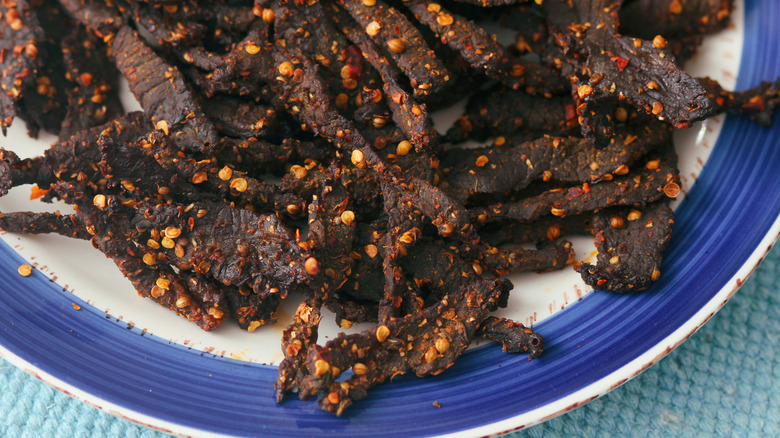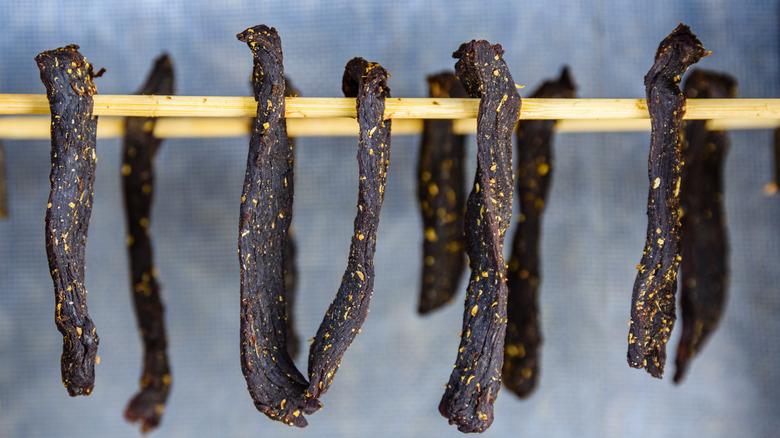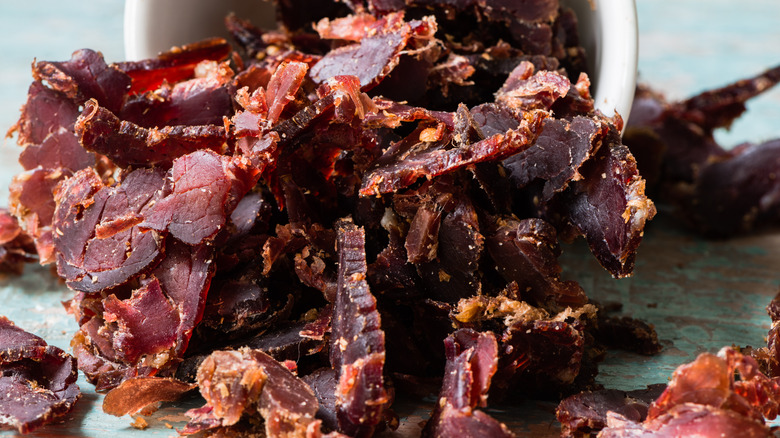The Difference Between Biltong And Beef Jerky
Whether you're hitting a mountain trail, embarking on a road trip, or just looking for a high-protein, low-carb snack, beef jerky is a practical food that's been consumed for hundreds of years, according to Food Preserving. It's shelf-stable, portable, natural, and nutrient-dense — perfect for everyone from nomads to cowboys, from woodsmen to the everyday modern eater.
But among the countless packaged goodies waiting in gas stations and supermarket checkout aisles, you may have spotted another meat snack: biltong. The name comes from the Dutch bil (rump) and tong (tongue or strip), explains Fine Dining Lovers. According to Karnivore, biltong originated with the indigenous people of South Africa, but the product sold today was influenced by Dutch colonists. In South Africa, sliced biltong is commonly shared like a bag of chips and may also be encountered as a slab or even a powder and added to other foods.
It should be noted that this article primarily discusses commercially-available biltong, not the authentic South African cured biltong, which is illegal to import into the U.S. without a certificate, according to the United States Department of Agriculture. Commercial biltong still offers a very different eating experience from jerky, though on paper they're a similar thing: dried red meat. But texture, flavor, and preparation methods set the two apart.
The preparations and textures are worlds apart
Open a bag of beef jerky and a bag of biltong side by side, and the first thing you'll likely notice is how different each product looks and feels. Perhaps you're not a fan of jerky's texture, which can be tough, stringy, and leathery. To make jerky industrially, lean beef is trimmed and defatted, cut up into strips, and treated with a curing solution before being slowly cooked or smoked. Many people also make jerky at home using a dehydrator or oven. Either way, moisture reduction is essential to the preservation process, preventing microorganism growth and slowing spoilage, as Britannica explains. But it leaves a little to be desired in the chewing department.
Biltong, by contrast, may be made with fattier cuts of meat from beef cattle or a slew of other tasty creatures. The meat is cut into large pieces or slabs, marinated with spices and vinegar to thwart unwanted microorganisms, and air-dried without the use of heat, says Runder. After a week or so, it's usually cut into slices that are thinner than your average jerky. The end result has a crumbly, flaky mouthfeel, sometimes compared to charcuterie.
Separate flavors to savor
Beef jerky is generally meaty, salty, and smoky and comes in a wide variety of tasty iterations, including sweet ones. Hot and spicy varieties hark back to the old days when chili pepper was necessary to keep insects from munching on it, recalls Food Preserving, while modern jerky recipes often call for brown sugar, soy sauce, Worcestershire sauce, garlic, or liquid smoke. Biltong, meanwhile, is frequently described as having an umami flavor — the rich and savory "fifth taste" — owing to its fattiness and amino acids, explains M-Eat! Dutch colonists also added ingredients like cloves, coriander, and black pepper to the traditional South African recipes, per Fine Dining Lovers, and many will say it's not biltong without them.
Biltong and jerky have similar nutritional profiles, according to Healthline — high in protein and relatively low in fat and carbohydrates. But both jerky and biltong also have a fair amount of sodium, and biltong in particular may contain a lot of saturated fat, Healthline cautions. Still, now that you know what biltong is and what makes it different from the beef jerky that's dominated the convenience store shelves for decades, it can be a good option in moderation for someone who's looking to shake up their protein intake. So if you have beef with jerky but you're after a meaty treat, you might want to give biltong a go.


